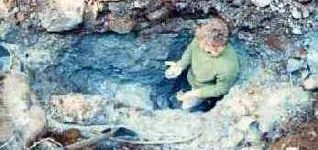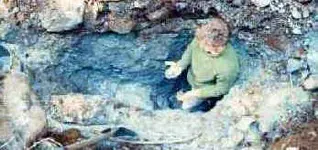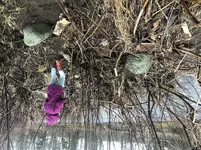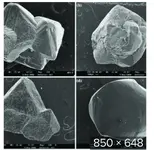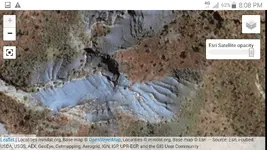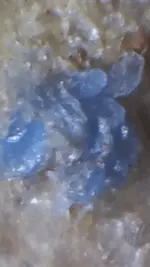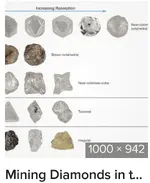You are using an out of date browser. It may not display this or other websites correctly.
You should upgrade or use an alternative browser.
You should upgrade or use an alternative browser.
BLUE CLAY
- Thread starter hmmm
- Start date
ancheta
Tenderfoot
- Joined
- May 22, 2013
- Messages
- 1
- Reaction score
- 1
- Golden Thread
- 0
- Primary Interest:
- All Treasure Hunting
I am a pigment specialist and I work with blue clay a lot when I do restoration of Native American artifacts. I'm interested in deposits of the clay. I'm trying to map deposits on the NW coast from southern Washington to SE Alaska. I've ID'd the blue clay we have here as vivianite, a ferrous phosphate mineral. It was used widely by NW Coast Natives and First Nations people. I'm trying to map deposits because I'm doing SEM and XRF analysis on all the samples I take from artifacts. I can match these samples to deposits by comparing the elemental data, looking for trace elements that are indigenous to particular deposits. This is helping us determine more closely the area in which a particular artifact originated. In some cases it's helping us date some pieces as well. If anyone is willing to share what they know about blue clay in the Pacific NW, I'd be grateful. My email is copperwomanstudio@gmail.com.
hmmm
Hero Member
- Joined
- Jun 9, 2007
- Messages
- 830
- Reaction score
- 98
- Golden Thread
- 0
- Primary Interest:
- All Treasure Hunting
- #202
Thread Owner
i am fine with you testing and recording the clay deposit, but if you match my clay with a mask in Seattle that was made 200 years ago. i will have the Indians from down town Seattle coming to my mineral clam demanding i turn it over to them because there ancestor came here and took some 200 years ago .
 Sounds like a big headache.
Sounds like a big headache.
With that said, have you looked into maya blue?
my clay is a type of kaolin clay, would you classify this as vivianite, a ferrous phosphate mineral.
 Sounds like a big headache.
Sounds like a big headache. With that said, have you looked into maya blue?
my clay is a type of kaolin clay, would you classify this as vivianite, a ferrous phosphate mineral.
Sis
Jr. Member
- Joined
- Jan 29, 2013
- Messages
- 77
- Reaction score
- 11
- Golden Thread
- 0
- Location
- Breezy Hills
- Detector(s) used
- Dreams, Spirits, Premonitions
- Primary Interest:
- Other
I've either read or heard tell of the local native Indians digging through the blue clay around the creeks or rivers and finding a substance that is similar to opals. But, that's all I know. I think it would be cool to find some.
skypaiger2
Tenderfoot
- Joined
- Jan 5, 2014
- Messages
- 3
- Reaction score
- 0
- Golden Thread
- 0
- Primary Interest:
- All Treasure Hunting
im new to this site,but trying to get good ideas on the blue clay. I live in georia,and in my back yard I have 2 small creeks that form into one.
anyhow,about 3 ft from the surface is a line of blue clay,anywhere from a foot to 3-4 ft thick. it follows all 3 creeks. have not found any gold,but real curious of the silver.i will have to have some tested.. anyone tell me here to send it to so it can get tested?? I would appreciate it.
and as for how im separating the clay from rock. its just me so I put a couple shovel fulls in a strainer, that is on top of a 5 gallon bucket.. run water over it to turn it into like a pudding. and frm there I put in the pan and let a current wash it away,leaving the heavy stuff at bottom. getting lots of black sand,so im hoping to hit gold sooner or later. but I am going to have it tested for silver and such...
ty for any feed back. and good luck to everyone
anyhow,about 3 ft from the surface is a line of blue clay,anywhere from a foot to 3-4 ft thick. it follows all 3 creeks. have not found any gold,but real curious of the silver.i will have to have some tested.. anyone tell me here to send it to so it can get tested?? I would appreciate it.
and as for how im separating the clay from rock. its just me so I put a couple shovel fulls in a strainer, that is on top of a 5 gallon bucket.. run water over it to turn it into like a pudding. and frm there I put in the pan and let a current wash it away,leaving the heavy stuff at bottom. getting lots of black sand,so im hoping to hit gold sooner or later. but I am going to have it tested for silver and such...
ty for any feed back. and good luck to everyone
A_Sly1_U
Jr. Member
- Joined
- Jun 2, 2013
- Messages
- 49
- Reaction score
- 22
- Golden Thread
- 0
- Primary Interest:
- All Treasure Hunting
You should check out LaRune's Rockpecker if you're interested in doing the testing to see what minerals your clay holds. If you have a reasonable understanding of chemistry the tests are very easy to follow. These tests do require a few tools and a few chemicals that most of us would have to go out and buy. It's a must have book for any rock hound/prospector even if you never use the tests. In all honesty it would probably be cheaper and less headache to send samples of your heavies off to a lab to have them analized.
plopdawg
Tenderfoot
- Joined
- May 19, 2014
- Messages
- 1
- Reaction score
- 1
- Golden Thread
- 0
- Primary Interest:
- All Treasure Hunting
On the beach in san diego saw some very large exposed in the sand formations of light blue clay with red spots, at the base of a cliff where a small stream of water was coming out of the cliff. Came across this great website and after read thru this thread on blue clay, got very interested in what it might be and might contain. Is anyone familiar with this formation ? Tried to upload pic, but wouldn't take. Thx in advance 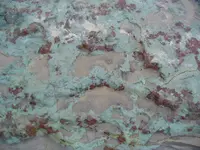

DizzyDigger
Gold Member
- Joined
- Dec 9, 2012
- Messages
- 6,644
- Reaction score
- 13,982
- Golden Thread
- 0
- Location
- Concrete, WA
- Detector(s) used
- Nokta FoRs Gold, a Gold Cube, 2 Keene Sluices and Lord only knows how many pans....not to mention a load of other gear my wife still doesn't know about!
- Primary Interest:
- Prospecting
Interesting looking stuff, for sure. With all that black sand
that is present it certainly would be worth seeing if it holds
any small gold.
BTW, welcome to the site..
that is present it certainly would be worth seeing if it holds
any small gold.
BTW, welcome to the site..

hmmm
Hero Member
- Joined
- Jun 9, 2007
- Messages
- 830
- Reaction score
- 98
- Golden Thread
- 0
- Primary Interest:
- All Treasure Hunting
- #209
Thread Owner
Hi all, i noticed something interisting about my clay that is a good selling point. it has 27% gemstone in it. the quantitative phase analysis shows 4.1% prehnite 2.3% diopside and 19.9% non fibrous actinolite. this is why it is so green.
Diposide is the interesting one , it is often found in kimberlite dikes and veins.
cheers
Diposide is the interesting one , it is often found in kimberlite dikes and veins.
cheers

Shardaisy
Tenderfoot
- Joined
- Jan 27, 2021
- Messages
- 1
- Reaction score
- 1
- Golden Thread
- 0
- Primary Interest:
- All Treasure Hunting
Washed up boulders of clay
I realize this is an older thread, but I enjoyed learning about the clay. I’m in Oregon and I frequent the local rivers often. Recently the water levels were flood stage. Levels have went down so I was excited to get back out and find new treasure. One river park was covered in water, clear up to the parking lot. Anywho today I took my kids down to check it out, and there’s washed up clay everywhere. Lots of green, and other colors. I was curious about the benefits of clay. If I should collect some.. I learned it works at filtering water, to make pottery, makeup and for healing skin. I didn’t think about potential gold.. I may go back with a bucket or 2 to collect samples. Hopefully I can attach a pic of our trip out today. Any knowledge on the green boulders of clay is much appreciated.
I realize this is an older thread, but I enjoyed learning about the clay. I’m in Oregon and I frequent the local rivers often. Recently the water levels were flood stage. Levels have went down so I was excited to get back out and find new treasure. One river park was covered in water, clear up to the parking lot. Anywho today I took my kids down to check it out, and there’s washed up clay everywhere. Lots of green, and other colors. I was curious about the benefits of clay. If I should collect some.. I learned it works at filtering water, to make pottery, makeup and for healing skin. I didn’t think about potential gold.. I may go back with a bucket or 2 to collect samples. Hopefully I can attach a pic of our trip out today. Any knowledge on the green boulders of clay is much appreciated.
Attachments
Last edited:
Tesorodeoro
Bronze Member
- Joined
- Jan 21, 2018
- Messages
- 1,707
- Reaction score
- 2,747
- Golden Thread
- 0
- Primary Interest:
- All Treasure Hunting
I’d love to see this thread revived....hmmmm you still mining clay?
russau
Gold Member
- Joined
- May 29, 2005
- Messages
- 7,628
- Reaction score
- 7,270
- Golden Thread
- 0
- Location
- St. Louis, missouri
I just watched a show that talked of the Myan's (Montezuma's venture north) and they say the blue clay was/is reserved for Mayan's Royalty and some petroglyph's have the blue clay on them to show royalty.
Tesorodeoro
Bronze Member
- Joined
- Jan 21, 2018
- Messages
- 1,707
- Reaction score
- 2,747
- Golden Thread
- 0
- Primary Interest:
- All Treasure Hunting
I just watched a show that talked of the Myan's (Montezuma's venture north) and they say the blue clay was/is reserved for Mayan's Royalty and some petroglyph's have the blue clay on them to show royalty.
Somewhere in the thread a lady requested to study the blue clay because she was trying to build a database of origins so she could assist in identifying where certain NA artifacts were from.
Ohiogoldfever
Hero Member
- Joined
- Oct 15, 2020
- Messages
- 863
- Reaction score
- 3,022
- Golden Thread
- 0
- Location
- Dayton Ohio
- Primary Interest:
- All Treasure Hunting
Great read! I have a few nice piles of blue clay around. I have dried, crushed and panned some with pretty mild results. I may try and smelt some.... see if I can recover any silver. It seems I find blue clay where I find bedrock or areas of possible breaking down of bedrock.
Hmmm
Hmmm
Hi, im new to this post so if I repeat what has already been stated or is known commonly please forgive me. Here goes..
hmmmm
that is very interisting.
there is a dike of what we thought was kimberlight up stream, in the center of the crator, unfortunitly its burried now, thank you loggers.
whats intristing is we pann fine gold about 1 km down stream from the end of the blue ground where the bedrock is exposed.
the gold is very course, but what is odd is the "pink sand "we get. it has very heavy quartz looking crystles in it.
have a look.
Ive been in the diamond explorartion corner and are currently following a blue clay find here in Australia. So im interested inresearching is there an overlap.
Ill start by hitting known points of others that have posted here
1 magnetite.. magnetite is a common morphology of altered olivine. Olivine being one of the largest by proportion indicators for diamond, howevever the first to alter. The high magnesium content of olivine often gives magnetite cores or spinel cores in the matrix. Olivine also pseudomorphs into blue ground, kimberlite into clays.
Im kooking at your pictures of "pink sand" and although we shouldn't say untill viewing through a microscope. This looks like classic "diamond indicator minerals" (kims) for short. Im seeing "picroilmenite" and/or chrome spinel/chromite. small reds could be pyrope garnet., and pinks eclogitic garnet (classic colours) also although its not clear there are some clear crystals that match diamond crystalography/morphology (tetrahedronic) your showing what looks like (but is unchecked) classic KIMS minus purple garnet, but they are not essential. Im not used to typing into a scrolling page so im going to break this now read what ive submitted and begin a new reply with more if allowed. Much to say regarding blue clay and kimberlite/lamporite
Im going to pop in some points that should be said first up.Hi, im new to this post so if I repeat what has already been stated or is known commonly please forgive me. Here goes..
Ive been in the diamond explorartion corner and are currently following a blue clay find here in Australia. So im interested inresearching is there an overlap.
Ill start by hitting known points of others that have posted here
1 magnetite.. magnetite is a common morphology of altered olivine. Olivine being one of the largest by proportion indicators for diamond, howevever the first to alter. The high magnesium content of olivine often gives magnetite cores or spinel cores in the matrix. Olivine also pseudomorphs into blue ground, kimberlite into clays.
Im kooking at your pictures of "pink sand" and although we shouldn't say untill viewing through a microscope. This looks like classic "diamond indicator minerals" (kims) for short. Im seeing "picroilmenite" and/or chrome spinel/chromite. small reds could be pyrope garnet., and pinks eclogitic garnet (classic colours) also although its not clear there are some clear crystals that match diamond crystalography/morphology (tetrahedronic) your showing what looks like (but is unchecked) classic KIMS minus purple garnet, but they are not essential. Im not used to typing into a scrolling page so im going to break this now read what ive submitted and begin a new reply with more if allowed. Much to say regarding blue clay and kimberlite/lamporite
One that kimberlite pipes/dykes (if thats what it is) never happen in singles. But clusters.
Two that it is extremely unlikely tou would find identifiable olivine remaining.
Three that large companies would launch huge exploration programs on the find of just one or two kimberlitic looking chromites , please do image searches on these terms im using to unpack what im getting at. Now blue clay... what im finding in Australia and by some reads here is they are commonly narrow dykes and sills of a mineral deposit. I am definitely seeing dykes with lens opening tops here in aus. My wondering is this... silver chloride is also blue is the blue pigment silver chloride in carbonate (carbonate being a major portion of kimberlite)... and secondary is the clay (kimberlite?) A heavies trap for the gold deposit that is being released somewhere else? That being the association.? I intend to explore this further myself but please do searches on the terms ive used here to explore the possible consequences yourself. Also keep your deposit a secret until youve nutted this out, bless you all
DizzyDigger
Gold Member
- Joined
- Dec 9, 2012
- Messages
- 6,644
- Reaction score
- 13,982
- Golden Thread
- 0
- Location
- Concrete, WA
- Detector(s) used
- Nokta FoRs Gold, a Gold Cube, 2 Keene Sluices and Lord only knows how many pans....not to mention a load of other gear my wife still doesn't know about!
- Primary Interest:
- Prospecting
Jono...great ideas, but I think starting a new thread would be best.
Lastly (for the moment) im finding blue clay dykes and pipes as a by product of "shear zone" "greenstone" complexes. So these finds of "metal" state mineral (also packaged as chlorides, nitrates ect) are just simply the tiny volume of mineral that made it to metal state. The rest being held and unidentified as sulphide deposits (look up kalgoorlie golden mile or any greenstone gold deposit) pics time this is some of what im tracking/sampling the close up blue crystals are in hand sample to test for silver chloride. Lead could possibly hide as blue also but is less likely in this scenario. Pic 3 is one of the big fellas around here and on closer view it is also dark grey/black. Silver also turns black in chemical state in the presence of light. Last few pics are of diamond morphology. Which is the alteration of diamond crystal altered and resorbed from the chemistry and heat of ascention in the kimbelite pipe. I must note that the previos pics posted are definitely not diamond. Surface "tetrahedrons" or "macles" shapes in any firm are what your primarily looking for initially. But they dont have to be there. Do some searcheHi, im new to this post so if I repeat what has already been stated or is known commonly please forgive me. Here goes..
Ive been in the diamond explorartion corner and are currently following a blue clay find here in Australia. So im interested inresearching is there an overlap.
Ill start by hitting known points of others that have posted here
1 magnetite.. magnetite is a common morphology of altered olivine. Olivine being one of the largest by proportion indicators for diamond, howevever the first to alter. The high magnesium content of olivine often gives magnetite cores or spinel cores in the matrix. Olivine also pseudomorphs into blue ground, kimberlite into clays.
Im kooking at your pictures of "pink sand" and although we shouldn't say untill viewing through a microscope. This looks like classic "diamond indicator minerals" (kims) for short. Im seeing "picroilmenite" and/or chrome spinel/chromite. small reds could be pyrope garnet., and pinks eclogitic garnet (classic colours) also although its not clear there are some clear crystals that match diamond crystalography/morphology (tetrahedronic) your showing what looks like (but is unchecked) classic KIMS minus purple garnet, but they are not essential. Im not used to typing into a scrolling page so im going to break this now read what ive submitted and begin a new reply with more if allowed. Much to say regarding blue clay and kimberlite/lamporite
Attachments
Right, good point but im trying to direct this member how to check what he has and whyJono...great ideas, but I think starting a new thread would be best.
Id just like to add that although this is generally known as true it no longer holds. Argyle mine in Australia is proterozoic as are many greenstone belts. Both paying kimberlite and lamporite can be found off craton (off archaeon)Tuberale brings up an interesting point. I have only recently studied diamond prospecting, but I found this map on the Colorado prospectors forum which shows where the economic diamond deposits are found.
So far, economically viable kimberlite bearing diamond deposits have only been found in the Archons.
Similar threads
- Suggestion
- Replies
- 12
- Views
- 596
Users who are viewing this thread
Total: 1 (members: 0, guests: 1)



